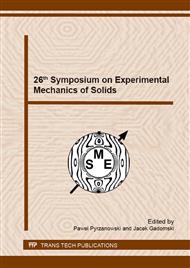p.3
p.11
p.17
p.25
p.31
p.36
p.42
p.49
Experimental-Numerical Study of Manufacture Induced 3D Rail Residual Stress
Abstract:
The purpose of this research was to investigate the changing patterns of the 3D rail residual stress as it accumulates on different portions of the rail manufacturing process. These patterns are of interest for manufacturers and railroad companies but also could serve as initial fields for various further numerical analyses of actual residual stress states in rails, wear and crack formation/development. Examined were four rail samples taken directly from manufacturing: 1. an air cooled rail; 2. an air cooled and roller straightened rail; 3. a head hardened rail; 4. a head hardened and roller straightened rail. An advanced experimental-numerical hybrid technique was developed and applied to perform all the required data reduction tasks. It comprises of an sectioning scheme called as the transverse/oblique slicing (T/O-S) technique and of a physically reasonable data reduction/smoothing procedure called as the global method (GM). Destructive experimental examinations were performed with the neutron diffraction method on thin rail slices at atomic reactor facility of US DOC, NIST Center for Neutron Research in Gaithersburg, MD. In the paper presented and discussed are results of the performed analyses.
Info:
Periodical:
Pages:
17-24
Citation:
Online since:
August 2015
Authors:
Price:
Сopyright:
© 2016 Trans Tech Publications Ltd. All Rights Reserved
Share:
Citation:


